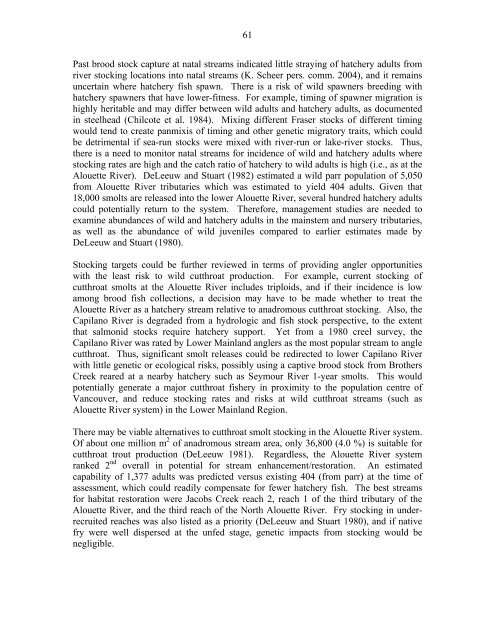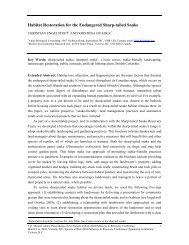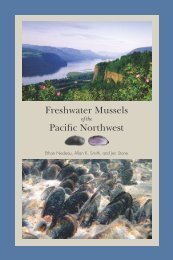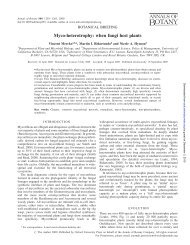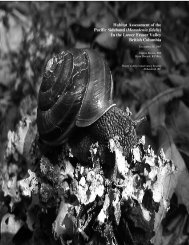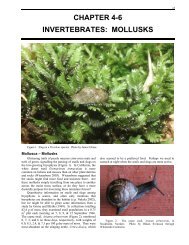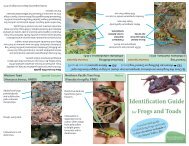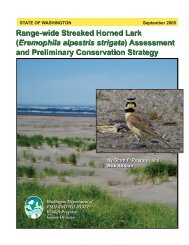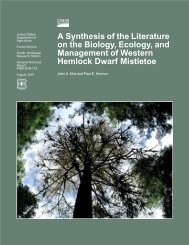Coastal Cutthroat Trout as Sentinels of Lower Mainland Watershed ...
Coastal Cutthroat Trout as Sentinels of Lower Mainland Watershed ...
Coastal Cutthroat Trout as Sentinels of Lower Mainland Watershed ...
Create successful ePaper yourself
Turn your PDF publications into a flip-book with our unique Google optimized e-Paper software.
61P<strong>as</strong>t brood stock capture at natal streams indicated little straying <strong>of</strong> hatchery adults fromriver stocking locations into natal streams (K. Scheer pers. comm. 2004), and it remainsuncertain where hatchery fish spawn. There is a risk <strong>of</strong> wild spawners breeding withhatchery spawners that have lower-fitness. For example, timing <strong>of</strong> spawner migration ishighly heritable and may differ between wild adults and hatchery adults, <strong>as</strong> documentedin steelhead (Chilcote et al. 1984). Mixing different Fr<strong>as</strong>er stocks <strong>of</strong> different timingwould tend to create panmixis <strong>of</strong> timing and other genetic migratory traits, which couldbe detrimental if sea-run stocks were mixed with river-run or lake-river stocks. Thus,there is a need to monitor natal streams for incidence <strong>of</strong> wild and hatchery adults wherestocking rates are high and the catch ratio <strong>of</strong> hatchery to wild adults is high (i.e., <strong>as</strong> at theAlouette River). DeLeeuw and Stuart (1982) estimated a wild parr population <strong>of</strong> 5,050from Alouette River tributaries which w<strong>as</strong> estimated to yield 404 adults. Given that18,000 smolts are rele<strong>as</strong>ed into the lower Alouette River, several hundred hatchery adultscould potentially return to the system. Therefore, management studies are needed toexamine abundances <strong>of</strong> wild and hatchery adults in the mainstem and nursery tributaries,<strong>as</strong> well <strong>as</strong> the abundance <strong>of</strong> wild juveniles compared to earlier estimates made byDeLeeuw and Stuart (1980).Stocking targets could be further reviewed in terms <strong>of</strong> providing angler opportunitieswith the le<strong>as</strong>t risk to wild cutthroat production. For example, current stocking <strong>of</strong>cutthroat smolts at the Alouette River includes triploids, and if their incidence is lowamong brood fish collections, a decision may have to be made whether to treat theAlouette River <strong>as</strong> a hatchery stream relative to anadromous cutthroat stocking. Also, theCapilano River is degraded from a hydrologic and fish stock perspective, to the extentthat salmonid stocks require hatchery support. Yet from a 1980 creel survey, theCapilano River w<strong>as</strong> rated by <strong>Lower</strong> <strong>Mainland</strong> anglers <strong>as</strong> the most popular stream to anglecutthroat. Thus, significant smolt rele<strong>as</strong>es could be redirected to lower Capilano Riverwith little genetic or ecological risks, possibly using a captive brood stock from BrothersCreek reared at a nearby hatchery such <strong>as</strong> Seymour River 1-year smolts. This wouldpotentially generate a major cutthroat fishery in proximity to the population centre <strong>of</strong>Vancouver, and reduce stocking rates and risks at wild cutthroat streams (such <strong>as</strong>Alouette River system) in the <strong>Lower</strong> <strong>Mainland</strong> Region.There may be viable alternatives to cutthroat smolt stocking in the Alouette River system.Of about one million m 2 <strong>of</strong> anadromous stream area, only 36,800 (4.0 %) is suitable forcutthroat trout production (DeLeeuw 1981). Regardless, the Alouette River systemranked 2 nd overall in potential for stream enhancement/restoration. An estimatedcapability <strong>of</strong> 1,377 adults w<strong>as</strong> predicted versus existing 404 (from parr) at the time <strong>of</strong><strong>as</strong>sessment, which could readily compensate for fewer hatchery fish. The best streamsfor habitat restoration were Jacobs Creek reach 2, reach 1 <strong>of</strong> the third tributary <strong>of</strong> theAlouette River, and the third reach <strong>of</strong> the North Alouette River. Fry stocking in underrecruitedreaches w<strong>as</strong> also listed <strong>as</strong> a priority (DeLeeuw and Stuart 1980), and if nativefry were well dispersed at the unfed stage, genetic impacts from stocking would benegligible.


